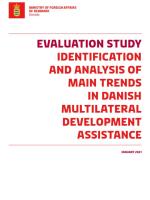Earmarking of Danish multilateral development assistance is increasing
Danish multilateral assistance is often debated. Which share of Danish development assistance should be channeled through multilateral organizations, and should the assistance be provided as core or earmarked funding? What are the underlying determinants of Danish multilateral policy choices?
These and other questions are analysed and discussed in this new study, which is based on a detailed quantitative analysis of Danish multilateral assistance 2011-18. Some of the main conclusions in the study are that an increasing share of Danish development assistance is channeled through multilateral organisations, and in particular as soft earmarked funding, but that a decreasing share is targeted at Africa. The paper questions whether the increased earmarking has strengthened Danish influence in the multilateral organisations.
The study has also looked at the impact of the refugee crisis on multilateral funding and shows a significant upward trend in 2017-18. A section in the study discusses various potential explanations of main trends in Danish multilateral assistance and finds not only significant stability in the multilateral organisations that are the main receivers of Danish development assistance but also a tendency to do what comparable donor countries do.
The study has received financial support from the Danish Ministry of Foreign Affairs.
DIIS Experts


